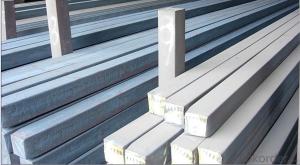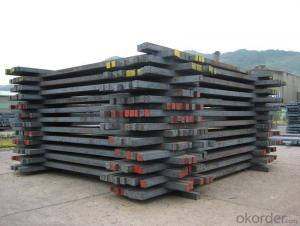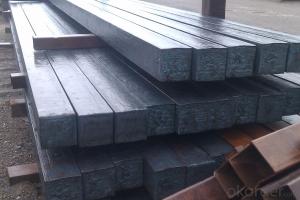Q235/3SP 120MM Blast Furnace Hot Rolled Steel Billet
- Loading Port:
- Tianjin
- Payment Terms:
- TT OR LC
- Min Order Qty:
- 2000 m.t.
- Supply Capability:
- 30000 m.t./month
OKorder Service Pledge
OKorder Financial Service
You Might Also Like
Description of Q235/3SP 120MM Blast Furnace Hot Rolled Steel Billet
Our hot dip galvanised steels consist of a steel substrate with a metallic zinc coating applied by means of a continuous hot dip galvanising process. Metallic zinc coatings are available in steel grades ranging from steel for bending and deep drawing applications, to structural steels and high yield strength steels.
A glossy surface finish obtained under specific skin-pass conditions (either non-skin-passed or skin- passed with smooth cylinders to obtain low roughness) can be provided if required at time of enquiry.
Advantage of Q235/3SP 120MM Blast Furnace Hot Rolled Steel Billet
Uncoated CR steel sheet With the features of in line with the international highest standards in demension and shape, excellent surface finish and properties, the products are mainly used in home appliance and automobile industries.
Galvanized steel sheet(include HDG and EG)
With the features of good corrosion resistance, the products are mainly used in automobile, home appliance, electronics, building and machinery manufacture industries, etc.
Precoated steel sheet With the features of enviromental protection and good processablility, long lasting surface durability, rich in colors, the products are maily used in building, home appliance and furniture industries, etc.
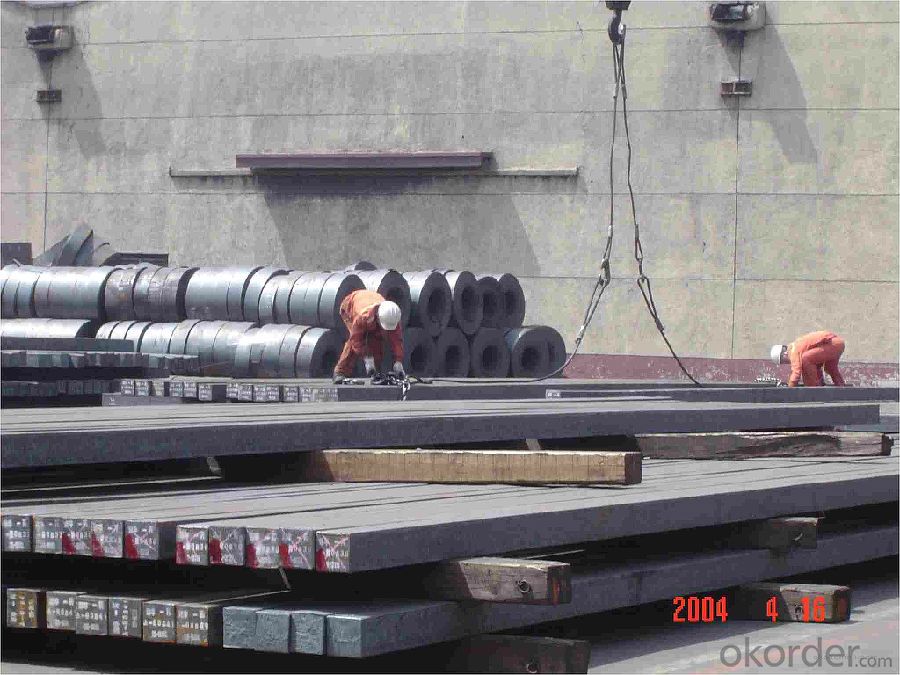
Applications of Q235/3SP 120MM Blast Furnace Hot Rolled Steel Billet
Our hot dip galvanised steels can be used in a very wide range of applications for industrial markets, both indoors and outdoors. Some of the most common applications are:
Building: wide sections for roofing and cladding, doors, door frames, metallic ceilings, partitions, structural members etc
Domestic appliances: all appliances for this sector (both white and brown goods) are manufactured with hot dip galvanised steels
Miscellaneous: electrical cabinets, aeraulic components, air conditioners, road signs etc
Zinc hot dip galvanised steel is suitable for contact with foodstuffs under certain conditions, as specified in European directive 89/109/EEC and French standard NF A 36-712-1. Please contact us for further information on this subject.
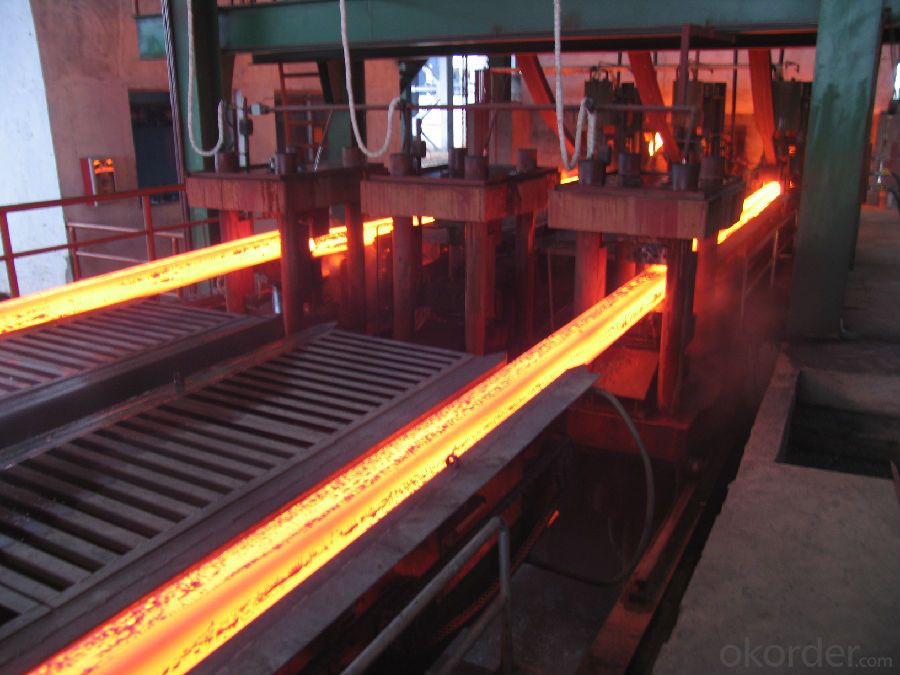
Specifications of Q235/3SP 120MM Blast Furnace Hot Rolled Steel Billet
Quality | Q/BQB 440-2003 | JIS G3312-1994 JIS G3321 | EN 10326-2004 | ASTM A653-02a |
EN 10327-2004 | (BASE PLATE) | |||
(BASE PLATE) | ||||
Commercial Steel | DC51D | SGCC SGLCC | DX51D+Z DX51D+AZ | CS Type A/B/C |
Forming Steel | St01,St02,St03 | SGCD1 SGLCD1 | FS Type A, Type B | |
Drawing | DC52D /DC53D | - | DX52D+Z DX52D+AZ | DDS TYPE A/C |
Steel | DX53D+Z DX53D+AZ | |||
Structural | S280GD (StE28) | SGC400 SGLC400 | S280D+Z DX54D+AZ | SS275 |
Steel | S350GD (StE34) | SGC440 SGLC440 | S350D+Z S350D+AZ | SS340 Class1 |
FAQ of Q235/3SP 120MM Blast Furnace Hot Rolled Steel Billet
We have organized several common questions for our clients,may help you sincerely:
1. How Can I Visit There?
Our company is located in Tianjin City, China, near Beijing. You can fly to Tianjin Airport Directly. All our clients, from home or aboard, are warmly welcome to visit us!
2. How Can I Get Some Sample?
We are honored to offer you sample.
3. Why choose CNBM?
Our delivery time about 15-20days for standard sizes, if you have other requirements like hardness, quanity and width ,it is about 20-40days. But don't worry we also try our best for the delivery time ,because time longer and our cost is higher.
- Q:How are steel billets used in the manufacturing of defense equipment?
- Steel billets are an essential component in the manufacturing of defense equipment due to their strength, durability, and versatility. Defense equipment, such as armored vehicles, tanks, and artillery, requires materials that can withstand extreme conditions and provide optimal protection. Steel billets, which are semi-finished steel products with a square or rectangular cross-section, serve as the raw material for various defense equipment components. These billets are typically melted and cast into specific shapes that meet the precise requirements of each equipment part. Once cast, steel billets are forged, heat-treated, and machined to create different defense equipment components like armor plates, gun barrels, missile casings, and vehicle frames. The high strength and impact resistance of steel billets make them suitable for these applications, ensuring the equipment can withstand ballistic impacts, blast forces, and other hostile conditions encountered in combat situations. Furthermore, steel billets can be easily welded, allowing for the assembly of complex structures and the integration of various components. This flexibility enables the creation of customized defense equipment designed to fulfill specific military needs. In addition to their mechanical properties, steel billets are also corrosion-resistant, which is crucial for defense equipment that may be exposed to harsh environmental conditions, including saltwater or extreme temperatures. This corrosion resistance ensures the longevity and reliability of the equipment, reducing maintenance requirements and costs. Overall, steel billets play a vital role in the manufacturing of defense equipment by providing the necessary strength, durability, and flexibility required for the equipment to perform effectively in combat situations. Their use ensures that defense forces have access to reliable and robust equipment that enhances their operational capabilities and protects the lives of military personnel.
- Q:What are the different surface treatments applied to steel billets?
- Depending on the desired outcome and application, steel billets can undergo several different surface treatments. Some common treatments include: 1. Shot Blasting: This method involves propelling small metal or mineral particles onto the steel billet surface at high speeds. Shot blasting effectively removes surface impurities like rust or scale, resulting in a clean and even surface. 2. Pickling: Pickling is a chemical treatment that submerges the steel billets in an acid solution, usually hydrochloric or sulfuric acid. This process eliminates oxide layers or scale from the billet surface, leaving it clean and smooth. 3. Phosphating: Phosphating is a chemical conversion coating process that involves immersing the steel billets in a solution containing phosphate salts. This treatment forms a thin, corrosion-resistant phosphate film on the surface. 4. Galvanizing: Galvanizing is a widely used surface treatment for steel billets, where a layer of zinc is applied. This process provides excellent corrosion protection and enhances durability. 5. Painting: Another common surface treatment is painting, where a layer of paint is applied to the steel billet surface. This not only enhances aesthetic appeal but also provides additional corrosion protection. 6. Electroplating: Electroplating involves depositing a thin layer of metal, such as chromium or nickel, onto the steel billet surface using an electrical current. This treatment improves appearance, corrosion resistance, and wear resistance. It is important to consider factors like intended use, environmental conditions, and cost when selecting a surface treatment for steel billets. Each treatment offers specific benefits, so choosing the most suitable option ensures optimal performance and longevity.
- Q:How do steel billets compare to other steel products?
- Steel billets are raw steel products that are formed into a specific shape, typically a square or rectangular cross-section. They are often used as a starting material for further processing and manufacturing of various steel products. Compared to other steel products, steel billets offer flexibility in terms of size and shape, allowing manufacturers to produce a wide range of end products. Additionally, steel billets possess superior strength and durability, making them an excellent choice for structural and construction applications.
- Q:Which is good for pure iron billet?
- Shanghai Xiyuan special steel products Co., Ltd. was founded in 1997 China long-term sales of imported and domestic first-line steel industrial pure iron (iron burden, magnetic iron, electrical iron) of M6 steel, 08F steel, 91F steel and other special steel products, special specifications according to user needs production organization, reasonable price, quality optimization.
- Q:How are steel billets distributed in the market?
- Steel billets are distributed in the market through various channels and processes. These channels can be broadly categorized into three main methods: direct sales, through distribution networks, and online platforms. Direct sales involve manufacturers or steel mills selling their billets directly to customers, such as construction companies, fabricators, or steel service centers. This method allows manufacturers to have better control over pricing, quality, and delivery schedule. It also enables them to build direct relationships with customers and understand their specific requirements. Distribution networks play a significant role in the distribution of steel billets. These networks consist of wholesalers, distributors, and stockists who purchase steel billets from manufacturers and sell them to end-users or smaller retailers. Distribution networks have extensive market reach, allowing them to cater to a wide geographical area. They provide convenience to customers by maintaining an inventory of steel billets, ensuring timely availability and reducing lead times. In recent years, online platforms have emerged as a popular method for distributing steel billets. Online trading platforms connect buyers and sellers of steel billets, providing a convenient and efficient way to conduct business transactions. These platforms allow manufacturers to reach a global customer base, while buyers can access a wide range of suppliers and compare prices and specifications. Online platforms also provide transparency and reduce the need for intermediaries, resulting in cost savings. Regardless of the distribution method, the logistics of steel billets' transportation and storage are crucial. Steel billets are typically transported in bulk using various modes of transportation, including trucks, trains, or ships. To ensure the quality and integrity of the billets, proper storage facilities are necessary, which include warehouses or yards equipped with cranes and heavy-duty machinery. Overall, the distribution of steel billets involves a complex network of manufacturers, distributors, and online platforms, all working together to meet the diverse needs of customers. This ensures a steady supply of steel billets in the market, supporting various industries such as construction, manufacturing, and infrastructure development.
- Q:What is the role of steel billets in the manufacturing of wind turbines?
- The manufacturing of wind turbines heavily relies on steel billets, which are semi-finished steel products that usually come in rectangular or square shapes. These billets are used as raw materials to produce various wind turbine components. One vital application of steel billets in wind turbine manufacturing is for constructing the tower. The tower needs to possess exceptional strength and stability to bear the weight of the entire structure and withstand wind forces. Steel's high strength-to-weight ratio makes it an ideal material for tower construction. Initially, steel billets are cut and shaped into cylindrical sections, which are then welded together to form the tower structure. This ensures the tower's robustness and ability to withstand the harsh environmental conditions faced by wind turbines. Furthermore, steel billets find usage in manufacturing other components like the rotor hub and nacelle. The rotor hub connects the blades to the main shaft, while the nacelle houses the gearbox and generator. These components require high durability and reliability to ensure optimal wind turbine performance. Steel billets are meticulously molded and machined to obtain the desired shapes for creating these components, providing the necessary strength and structural integrity. Additionally, steel billets are employed in the production of various smaller parts essential for assembling and securing different wind turbine components, such as brackets, bolts, and fasteners. To summarize, steel billets form the foundation for wind turbine manufacturing. They are transformed into strong structures and components that constitute the essential parts of these renewable energy systems. Their strength, durability, and versatility make them vital materials in wind turbine production, guaranteeing reliable operation and contributing to sustainable energy generation.
- Q:How do steel billets contribute to the manufacturing of marine equipment?
- The manufacturing of marine equipment relies heavily on steel billets, which serve as crucial materials. These semi-finished products are utilized in the production of multiple marine components, including ship hulls, propellers, shafts, and other structural parts. The exceptional strength and durability of steel billets make them highly preferred in the marine industry. Given the harsh conditions that ships and other marine equipment endure, such as extreme temperatures, corrosive saltwater, and heavy loads, steel billets, composed of top-quality steel, possess the necessary strength to withstand these challenging environments. This ensures the long-term reliability and safety of the equipment. Additionally, steel billets offer the flexibility needed in marine equipment manufacturing to create complex shapes and designs. By easily molding and forging the billets into desired shapes, intricate components with precise specifications can be produced. This versatility enables the manufacturing of different marine equipment parts that are vital for the efficient operation of vessels. Another advantage of using steel billets in marine equipment manufacturing is their resistance to corrosion. Through the application of various protective coatings or alloys, steel billets can enhance their resistance to corrosion caused by exposure to seawater. This corrosion resistance is critical in preserving the integrity and longevity of marine equipment, ensuring their ability to withstand the harsh marine environment for extended periods. Furthermore, steel billets offer excellent weldability, making them suitable for the construction and repair of marine equipment. The ability to weld steel billets together allows for the seamless joining of different components, ensuring structural integrity and reducing the risk of failure. This welding capability facilitates the assembly and maintenance of marine equipment, enabling efficient production processes and cost-effective repairs. In conclusion, the strength, durability, versatility, corrosion resistance, and weldability of steel billets make them indispensable in the manufacturing of marine equipment. These qualities establish steel billets as the preferred choice for producing various marine components, guaranteeing the reliability, safety, and longevity of the equipment in the demanding marine environment.
- Q:What is the role of steel billets in the automotive industry?
- Steel billets play a crucial role in the automotive industry as they are used as the primary raw material for manufacturing various components and parts of vehicles. These billets are transformed into different shapes and sizes through processes like forging, rolling, and machining to create engine parts, chassis components, axles, and other structural elements. With their strength, durability, and versatility, steel billets enable the automotive industry to produce high-quality and reliable vehicles, ensuring safety and performance for drivers and passengers.
- Q:How are steel billets used in the production of automotive components?
- Automotive components heavily rely on steel billets as a crucial raw material. During the manufacturing process, these billets are heated and then either forged or rolled to form different shapes and sizes, ultimately creating the desired automotive parts. These billets serve as the foundation for producing crucial components such as engine blocks, crankshafts, connecting rods, axles, and suspension parts. Steel's high strength and durability make it the perfect material for these vital components, ensuring the safety and performance of automobiles. Once heated, the steel billets undergo various shaping processes, including hot forging or hot rolling. Hot forging involves applying pressure to the heated billet using a die to achieve the desired shape. This process not only finalizes the component's shape but also enhances its mechanical properties by aligning the steel's grain structure. On the other hand, hot rolling involves passing the heated billet through a series of rolling mills to gradually reduce its thickness and shape it into a specific profile. This method is commonly used for manufacturing long automotive components such as axles or suspension parts. Following the shaping process, the automotive components undergo additional manufacturing steps such as heat treatment, machining, and surface finishing to enhance their strength, precision, and aesthetic appeal. Steel billets offer numerous advantages in automotive component production. Their exceptional mechanical properties, including high strength, toughness, and wear resistance, make them ideal for withstanding the demanding conditions and loads experienced by automotive parts. Moreover, steel's malleability and formability enable manufacturers to create intricate and complex designs, ensuring optimal functionality and performance. In conclusion, steel billets play a crucial role in automotive component production by serving as the raw material that is shaped and formed into various critical parts. Steel's strength, durability, and versatility make it an essential material for ensuring the safety, reliability, and performance of automobiles.
- Q:What are the common sizes and shapes of steel billets?
- Steel billets come in various sizes and shapes depending on their intended use. Common sizes for steel billets range from 100mm to 300mm in diameter and 3 meters to 12 meters in length. Shapes can vary from round or square to rectangular, octagonal, or even irregular shapes, depending on the requirements of the specific industry or application.
1. Manufacturer Overview |
|
|---|---|
| Location | |
| Year Established | |
| Annual Output Value | |
| Main Markets | |
| Company Certifications | |
2. Manufacturer Certificates |
|
|---|---|
| a) Certification Name | |
| Range | |
| Reference | |
| Validity Period | |
3. Manufacturer Capability |
|
|---|---|
| a)Trade Capacity | |
| Nearest Port | |
| Export Percentage | |
| No.of Employees in Trade Department | |
| Language Spoken: | |
| b)Factory Information | |
| Factory Size: | |
| No. of Production Lines | |
| Contract Manufacturing | |
| Product Price Range | |
Send your message to us
Q235/3SP 120MM Blast Furnace Hot Rolled Steel Billet
- Loading Port:
- Tianjin
- Payment Terms:
- TT OR LC
- Min Order Qty:
- 2000 m.t.
- Supply Capability:
- 30000 m.t./month
OKorder Service Pledge
OKorder Financial Service
Similar products
New products
Hot products
Related keywords
